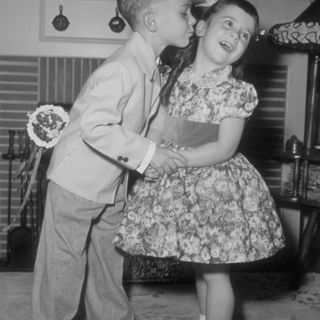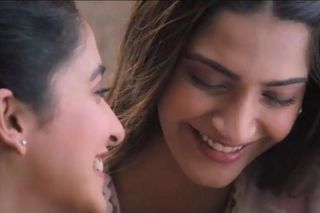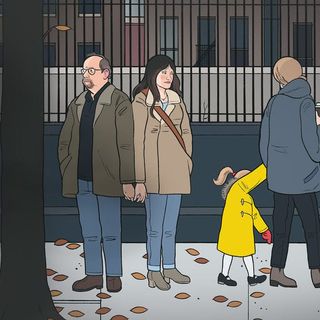
The Power of ‘Ek Ladki Ko Dekha Toh Aisa Laga’ Lies in Its Impact
It draws audiences in and dares to portray homosexuality as inarguably Indian.

In the second half of Ek Ladki Ko Dekha Toh Aisa Laga, Sahil Mirza (Rajkumar Rao), stages a play to tell the story of two girls falling in love. Mirroring the events that unfold in the film, about a Punjabi family whose daughter, Sweety, is queer, his hope is that his play will help Sweety’s family reconcile with her sexuality and open the minds of people in the small town of Moga who watch it.
Presenting his work to an unsuspecting audience, he asks that they watch it not with their heads, but their hearts. And this is what the play — and the film — banks on. If you watch it with your head, there are several critiques to be made, from the the timidity with which the film broaches the subject of homosexuality, to the small amount of screen time the actual couple is allowed. But there’s no question that Ek Ladki is incredibly powerful, not necessarily as a film itself, but because of its impact.
For queer folks sitting in the audience, watching a typical Bollywood storyline of mishaps and weddings, family drama and a happy ending, but with a queer lead, was probably unimaginable, until now. It’s difficult to put into words what that means for a community that’s been maligned, marginalized, and is only just starting to be granted their rights as equal citizens in this country. The flashbacks of Sweety as a child — feeling isolated and internalizing shame about her own sexuality, retreating to her diaries and resolving to lead a life in which she will always be alone — hit on very relatable queer experiences of growing up and growing into the realization that who you are is not okay. When Sweety tells Sahil her options are either running away to a different country, or to kill herself, it hints at the very real choices that some queer people make. The film makes it a point to bring up and refute all the usual misconceptions about homosexuality — that it’s a disease, that it’s just an import from the West, that it’s something that can be ‘fixed.’ Instead, by setting the film in a small town and having Sweety fit the ‘sundar susheel’ trope of the good Indian girl (who happens to like other good Indian girls), the film subverts stereotypes of what lesbian women must look like.
But perhaps crucially, unlike a movie like Angry Indian Goddesses where the #feminism was difficult to miss, Ek Ladki uses the usual filmy Bollywood narratives to draw people in and soften the shock of Sweety’s eventual confession. It opens with the mandatory wedding scene, in whichKuhu, played by a wonderful Regina Cassandra who sparkles despite her lack of screen time, tries to set Sweety up with her brother; in a flashback later, we find out that Kuhu also lets Sweety know she’s interested in women, which is how their love affair starts.
But Sweety’s family — an amiable papaji, Balbir Chaudhury (Anil Kapoor), and a matchmaking grandmother, Biji (Madhumati Kapoor) — don’t seem to take any notice. It’s only her brother, Babloo, played by Abhishek Duhan, who warns Sweety not to bring dishonor on the family. After a year of watching his sister’s blossoming relationship with Kuhu, who lives in the UK, Babloo tells his family that Sweety is secretly seeing someone — and uses a Muslim man as a stand-in for the kind of horror that a same-sex relationship would have for his family. Coincidentally, when Sahil, a struggling writer with something to prove to his film producer father, sees Sweety at a rehearsal, he falls in love and follows her from Delhi to her home in Moga. The first half of the film draws out Sweety’s climatic confession, instead weaving a confused web of miscommunication where Sahil is thought to be the non-existent Muslim boy Sweety likes.
Finally, just before the intermission, Sweety tells a drunk Sahil, who has crept into her room, that she’s not interested in men at all; she only likes women. The reaction — of Sahil and of people in the audience — is telling. It’s so ludicrous that it’s funny, and the audience laughs along with Sahil in the film. But the second half makes up for this, turning Sahil and his troupe member Chatro (Juhi Chawla) into allies who support Sweety and Kuhu’s relationship.
Sahil’s idea of helping the couple comes in the form of the play, also called ‘Ek Ladki Ko Dekha Toh Aisa Laga,’ in which Sweety and Kuhu essentially play themselves and act out the story of their love. The play is an interesting device from the screenwriter, Gazal Dhaliwal. Essentially, it sets up an audience watching the reactions of another audience, to the exact same story. And the people of Moga have a range of reactions, once they realize the unconventional twist of the story. Some yell about how inappropriate it is for two women to be together, some cover their children’s eyes, and many walk out. However, others, like a small girl with tears in her eyes, or an older man who leans over the empty VIP seats to watch, stay to witness something entirely new.
At the end of the play, Balbir runs onto the stage to save his daughter from the town’s ire, finally accepting that there’s nothing wrong with her sexuality and giving her his blessings to lead a life that will make her happy. And while that is a tear-jerking, moving scene in a way that only Bollywood can manage, it feels like the film is searching not for papaji’s acceptance, but for the audience’s. At the end, Sweety asks Sahil to take the play to different cities and towns, to save other girls like her. Though the dialogue comes off as moralistic, the sentiment feels like the crux of the film — to be palatable enough to draw audiences in, and daring enough to show a queerness that is inarguably Indian. It’s exactly what many of us have been waiting for.
Nadia Nooreyezdan is The Swaddle's culture editor. Since graduating from Columbia Journalism School, she spends her time thinking about aliens, cyborgs, and social justice sci-fi. She's also working on a memoir about her family's journey from Iran to India.
Related


The Buzz Cut: The Entrepreneur Spending Millions to ‘Biohack’ His Way to Living for 180 Years
